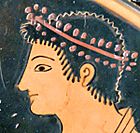Epiktetos facts for kids
Epiktetos was a very talented ancient Greek artist. He painted designs on vases, especially using a style called red-figure. This was a new and exciting way to decorate pottery back then. Epiktetos was one of the most important painters in a group known as the "Pioneer Group." He worked from about 520 BC to 490 BC. His name, Epiktetos, means "newly acquired." This might suggest he was once a slave.
Epiktetos: A Master Painter
At the start of his career, Epiktetos painted a large mixing bowl called a chalice krater. It was made by a potter named Andokides. Later, Epiktetos preferred to decorate smaller items like cups and plates. He worked with many different potters during his long career. These included Andokides, Hischylos, and the Nikosthenes-Pamphaios workshop.
Epiktetos even signed one plate as both the painter and the potter. This means he might have made the pot and painted it himself sometimes. That special plate was given as an offering on the Athenian Acropolis. He also worked with another painter, the Euergides Painter, on a drinking cup called a kylix. Epiktetos seemed to know how good he was. He signed more than half of the artworks that we know he created.
His Unique Style
Epiktetos's first vases were "bilingual" eye-cups. This means they used two different painting styles. The inside of the cup was painted using the black-figure technique. These designs often showed animals in circles. The outside of the cup used the red-figure technique. These designs featured patterns like palmettes, eyes, and sometimes people.
Even early on, Epiktetos was very skilled. He was better than Oltos at that time. He also avoided old-fashioned details like palmette-hearts. He used a special "relief-line" technique to make his lines stand out. Epiktetos was especially good at painting the inside circle of a cup, called a tondo. Often, his vases were only painted on the inside.
His small drawings were very delicate and precise. He used colors and decorations carefully and with great control. His lines and details were very balanced. The heads and limbs of his figures were perfectly proportioned. He was also very good at showing perspective, making figures look real.
Art experts have praised Epiktetos's work. John Beazley said, "it is not possible to draw better, only to draw differently." John Boardman called him the "greatest draughtsman in early red-figure vase painting."
-
Scythian archer, running while looking backwards and pulling an arrow from his quiver, cup, circa 520–500 BC. British Museum
Epiktetos liked to paint scenes from everyday life and parties. He rarely painted scenes from mythology. His mythological scenes often lacked new ideas. But his everyday scenes really showed off his skills and creative thinking. He helped to develop how the satyr was shown in art. Satyrs were often seen as wild, beast-like figures.
In his tondo paintings, Epiktetos stopped showing the "kneeling runner" that was common in black-figure vase painting. Instead, his figures would squat, kneel, or sit. Sometimes, the poses of the figures on his vases were almost the same. Even if their actions were very different, their body positions were similar.
We don't know exactly when Epiktetos stopped painting. One of his last works was on a cup made by the potter Python. Here, his style seemed to be influenced by Python's main painter, Douris. Another late work was on a vase by Pistoxenos.
Epiktetos's art must have been very popular back then. We know this because of a vase called a pelike by the Kleophrades Painter. This vase was falsely signed "Epiktetos egraphsen," which means "Epiktetos painted it." This fake signature suggests that people would pay more for a vase if they thought Epiktetos had painted it.
See also
 In Spanish: Epicteto (pintor) para niños
In Spanish: Epicteto (pintor) para niños



